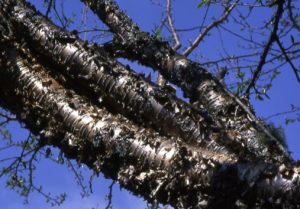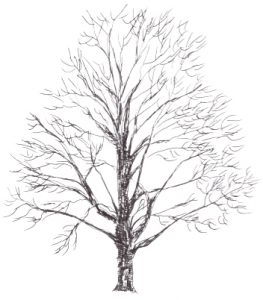Bulletin #2565, Native Trees and Shrubs for Maine Landscapes: Yellow Birch (Betula alleghaniensis)
Developed by Marjorie Peronto, Associate Extension Professor, University of Maine Cooperative Extension; and Reeser C. Manley, Assistant Professor of Horticulture, University of Maine.
For information about UMaine Extension programs and resources, visit extension.umaine.edu.
Find more of our publications and books at extension.umaine.edu/publications/.
Go native!
This series of publications is the result of a five-year research project that evaluated the adaptability of a variety of native trees and shrubs to the stresses of urban and residential landscapes in Maine. Non-native invasive plants pose a serious threat to Maine’s biodiversity. Plants such as Japanese barberry, shrubby honeysuckle, and Asiatic bittersweet, originally introduced for their ornamental features, have escaped from our landscapes, colonizing natural areas and displacing native plants and animals. By landscaping with native plants, we can create vegetation corridors that link fragmented wild areas, providing food and shelter for the native wildlife that is an integral part of our ecosystem. Your landscape choices can have an impact on the environment that goes far beyond your property lines.
Description

Form: a rounded tree with a well-defined main trunk, bearing stout, ascending limbs and slightly pendulous branchlets
Size: 50 to 75 feet high, and typically 2/3 as wide
Ornamental characteristics:
outer bark exfoliates horizontally in thin, papery curls, exposing a honey-gold inner bark
clear lemon to golden yellow fall foliage
Landscape Use
In a cool and moist area, yellow birch can grow to 75 feet in height with a similar canopy spread, and so it should be planted where it has room to grow. Use it as a canopy tree in the woodland landscape alongside paper birch (Betula papyrifera) and red oak (Quercus rubra), and sheltering striped maple (Acer pensylvanicum) and pagoda dogwood (Cornus alternifolia). Alternatively, plant it as a specimen tree in more open areas, and keep it mulched out from the trunk to three times the width of the canopy. Water it regularly in summer droughts. Avoid compacted soils and the heat-island effect associated with areas of extensive paving and building walls.
Autumn is a primary season of interest for yellow birch, when its leaves turn bright lemon yellow to golden yellow. In winter the honey-gold inner bark, revealed as the outer bark peels away in narrow, curling strips, glows in the low-angled sunlight, a reminder of another common name for this tree, curly birch. Place this tree where you can enjoy both of these features, each in its season.
Culture

Hardiness: USDA zone 3a
Soil requirements: prefers a cool, moist, well-drained soil
Light requirements: full sun or shade
Stress tolerances:
soil compaction — intolerant
pollution — intolerant
deicing salts — intolerant
urban heat islands — intolerant
drought — intolerant
seasonal flooding — tolerant
Insect and disease problems: infrequent
Wildlife Value
The yellow birch is a larval host for the banded purple and white admiral butterflies. Songbirds eat its seeds, and the tree is also a favorite nesting site for red-shouldered hawks.
Maintenance
Irrigation: During the establishment period, defined as one year after planting for each inch of trunk diameter at planting time, you should water your trees regularly during the growing season. Give the root zone of each tree 1 inch of water per week; in general, a tree’s root zone extends twice as wide as its canopy. After the establishment period, provide supplemental irrigation during periods of severe drought.
Fertilization: Landscape trees and shrubs should not be fertilized unless a soil test indicates a need. Correct soil pH, if necessary, by amending the backfill soil. No nitrogen fertilizer should be added at planting or during the first growing season.
To learn more about native woody plants
Visit the Eastern Maine Native Plant Arboretum at University of Maine Cooperative Extension’s Penobscot County office, 307 Maine Avenue in Bangor. Established in 2004, the arboretum displays 24 different native tree and shrub species that can be used in managed landscapes.
Reviewed by Cathy Neal, Extension professor, University of New Hampshire Cooperative Extension.
Photos by Reeser C. Manley.
Illustration by Margery Read, Extension Master Gardener.
 This series of publications and the associated research were made possible in part by the Maine Forest Service’s Project Canopy.
This series of publications and the associated research were made possible in part by the Maine Forest Service’s Project Canopy.
Information in this publication is provided purely for educational purposes. No responsibility is assumed for any problems associated with the use of products or services mentioned. No endorsement of products or companies is intended, nor is criticism of unnamed products or companies implied.
© 2008
Call 800.287.0274 (in Maine), or 207.581.3188, for information on publications and program offerings from University of Maine Cooperative Extension, or visit extension.umaine.edu.
The University of Maine is an EEO/AA employer, and does not discriminate on the grounds of race, color, religion, sex, sexual orientation, transgender status, gender expression, national origin, citizenship status, age, disability, genetic information or veteran’s status in employment, education, and all other programs and activities. The following person has been designated to handle inquiries regarding non-discrimination policies: Sarah E. Harebo, Director of Equal Opportunity, 101 North Stevens Hall, University of Maine, Orono, ME 04469-5754, 207.581.1226, TTY 711 (Maine Relay System).

